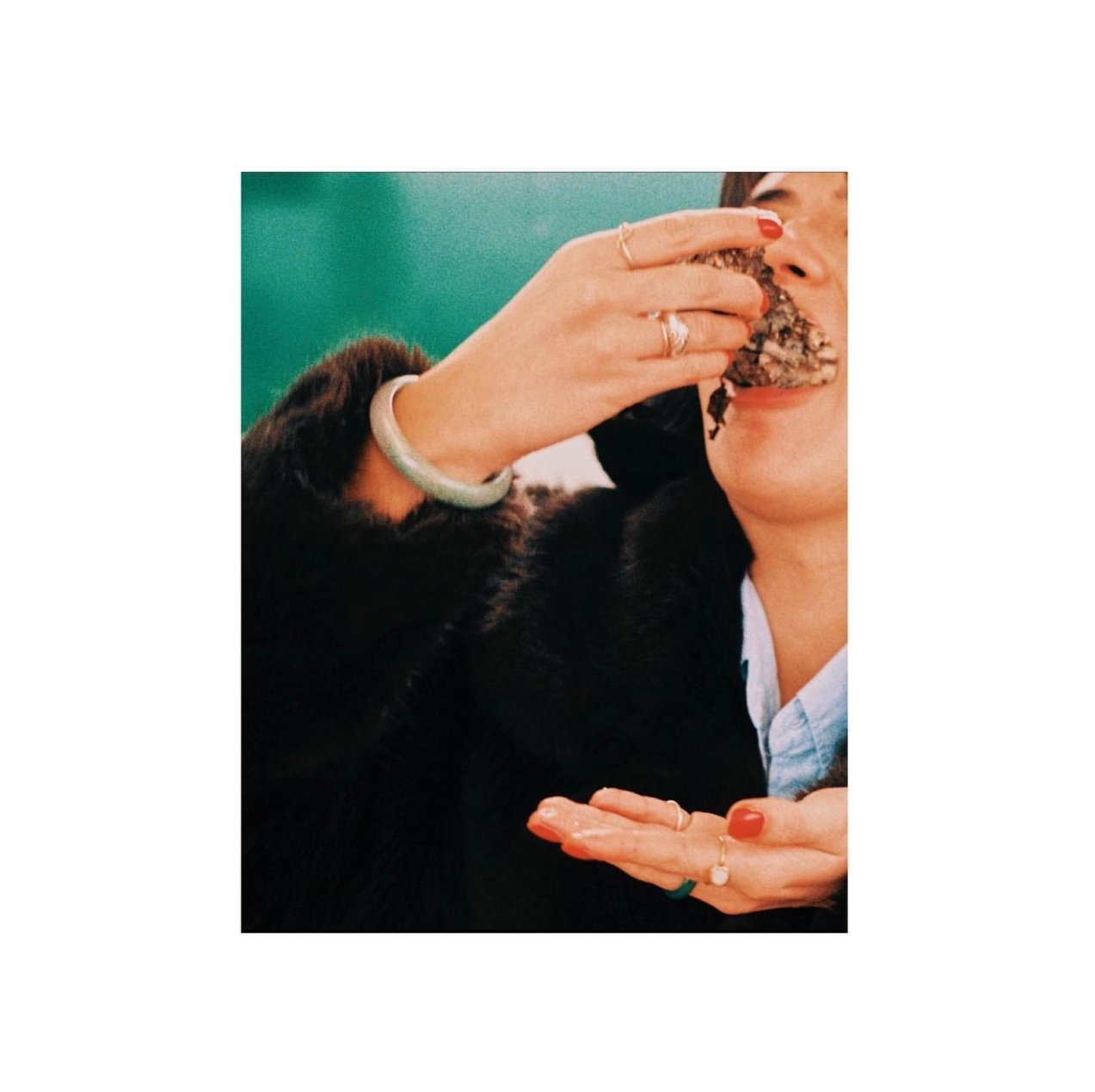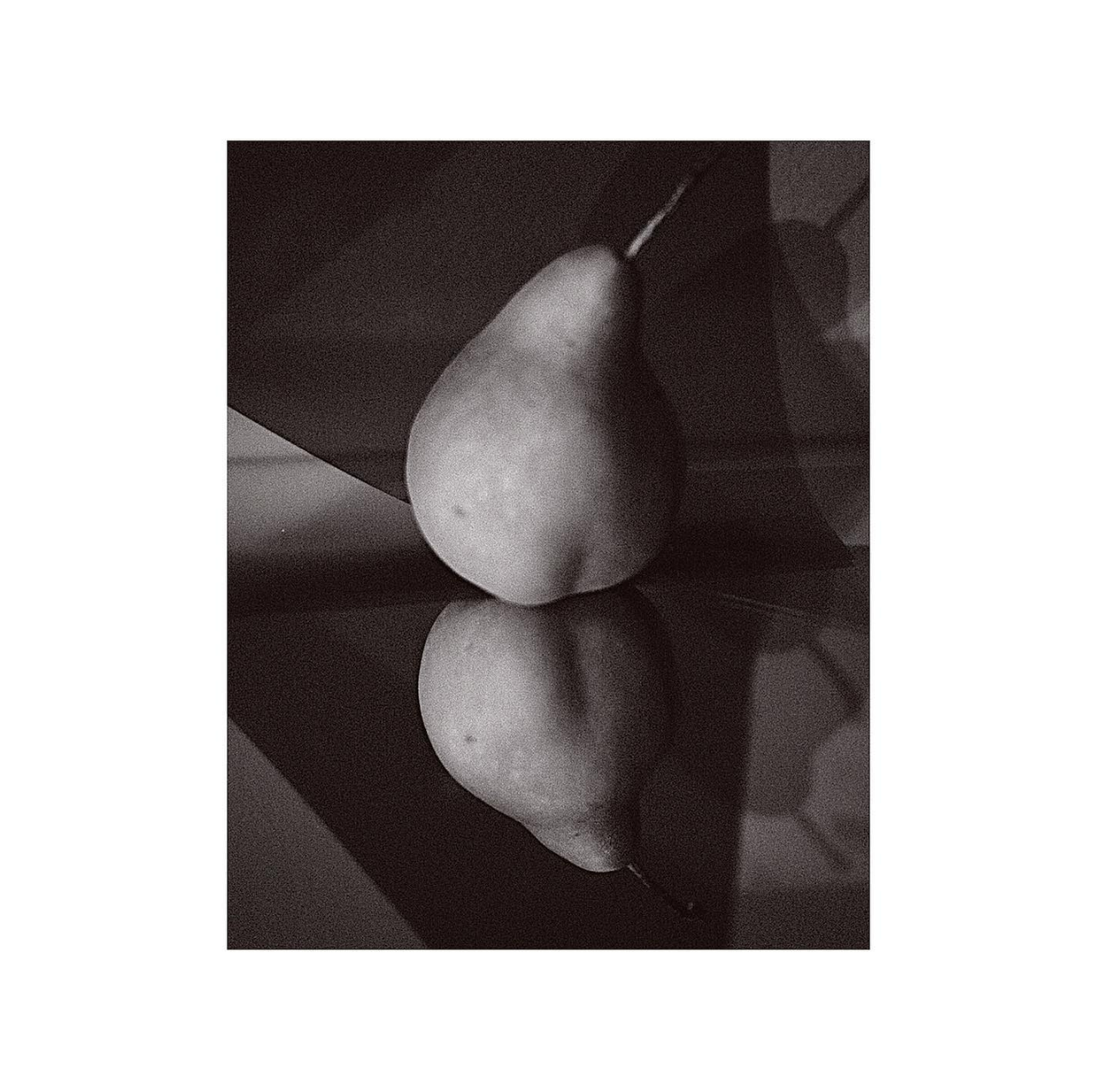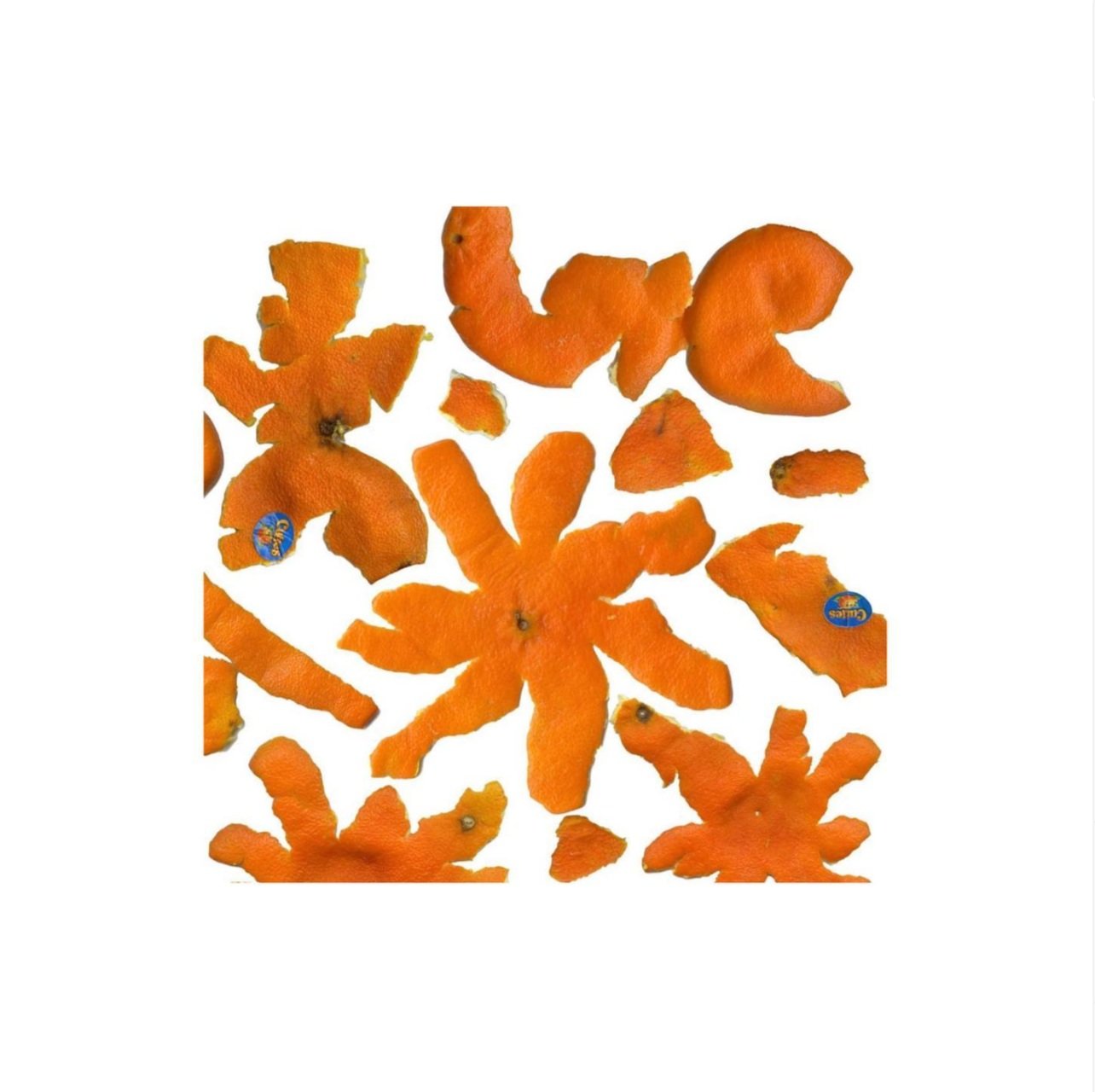in dialogue: for the corpse
“fruits de mer” #2019 🍈 I bussed 17-ish miles with 17+ pounds of market Summer fruits - melons warm and smelling like vanilla and honey, face-sized grape bunches - both in root-beer purple and sea glass green, velvety apricots and peaches and plump plums.
-
Am 22 min walk down the path from Eileen Grey’s E-1027 + Le Corbusier’s cabin, overlooking the beach cove with a single Grecian salt air bleached villa surrounded by maritime palms, set above the 16 seater open air La Cabanon seafood restaurant with one extra sand table for croissants and espresso and boxed white wine served with ice cubes, am across and down the coast from where tiny Monaco is sandwhiched between blue sky tres bluer water.
-
This is Cap Martin peninsula, a few coves east of Beaulieu-sur-Mer and a couple miles west of where you can step into Italy. Only traffic is a thin two-way road somewhere half way up the mega bluffs and a train rolling thru town every third hour-ish, rolling past pale pink villas drowning in sage colored pine trees and blooming vines, agave and Rosemary, eucalyptus and pistachio and olive trees. Where Eileen made a shaded outdoor kitchen near a place where Le Corbusier and Rebutato with their families sat for drinks and sunbathing.
Aubrey Devin is food stylist that weaves food rituals and culture through an eye of a fashion photographer with her project For the Corpse. We chatted about the central role of table in her creative expressions.
LG: Can you give us an overview of For the Corpse and the origin of its name?
-
AD: For The Corpse came about the night I met my friend Reid at a Christmas party. It was her beautiful English accent and my tequila chattiness that drew us together but then found a quick bonding over our mutual love for food. Our shared love and recognition of how food encourages creation and connectivity. Our backgrounds, in both career and eating are diverse, but we fully aligned in wanting to create a space for intentional gatherings where food was the centerpiece but also just the starting point for connecting.
Reid’s inspiration came from her design background, she also created interactive gallery spaces that incorporated food in London, she was searching to do something similar in LA. And it was from Reid where the name “For the Corpse” came, it’s to represent how we are all the same, all can be reduced to a simple body form but are nourished and come alive by life’s riches - food, pleasure, nature, beauty, love. And for me, I transitioned to food styling after almost 10 years as a restaurant line cook. I was missing cooking for actual eaters, but wanted something outside the normal restaurant setting.
I was really drawn to all types of functional art and their artists. I wanted to facilitate a space to showcase that art, it being interactive and dining-focused. Where creatively open minded people could gather around a shared table, that great equalizer, all being equally welcomed. A place that was without pretension or hesitation to start conversation with someone new seated next to them, where the evenings inspired insights were sincerely given and received. Where we let time be created by the guests to be a part of a long meal, eaten in pleasure amongst new friends and endless wine. Where the only agenda was for the food to be thoughtful and representative of a greater known shared theme and for the guests to take their time enjoying it and one another.
Basically a fun long dinner party.
That night, Reid and I promised each other a committed dinnerparty-throwing partnership/friendship. It was Reid’s groundedness that made me confident to follow through this commitment, which in LA is a novelty, but we did. And in a month and a half, For The Corpse threw an aphrodisiac heavy menu, Joan Collins Dynasty-Eque dress code, and a professional drag queen hosted Valentine's dinner party. We gutted a friend's downtown warehouse apartment, draped it in sheets of faux satin and baby's breath and pearl pinned roses, created a cherub and aphrodite statue photo booth, had two sold out nights of tables that sat 33, and everyone, even the drag queen, asked to be included in the next one.
“As told by PBS, the first known gingerbread recipe is from Greece in 2400 BC, followed by Chinese recipes in the 10th century, and finally hard gingerbread cookies cut out in shapes sold during medieval fairs in England, France, Holland, and Germany. It is said that Queen Elizabeth I ordered gingerbread cookies made and decorated to resemble visiting dignitaries. Elaborately decorated cookies were a symbol of wealth, often featuring gold leaf. The first gingerbread houses originated in 16th century Germany, though it is unclear whether the Brothers Grimm story of Hansel and Gretel or the houses came first.” - Alli Neal
“In a heart-warming tradition, men serve the women throughout the Christmas meal in Greenland.
The meal consists of mattak, strips of whale blubber encased in whale fat, and “kiviak,” a dish of flesh from auks buried in whole sealskin for several months and served once it begins to decompose. A popular dessert is Christmas porridge served with butter and topped with cinnamon and sugar.” - Chelsea Ritschel
Photo by @lau.renforde
“Stollen is first mentioned in 15th-century documents, though the recipe has changed significantly since then. Originally an Advent meal eaten in monasteries, the bland bread didn't include fruit or butter. It took six decades of a Saxon nobility effort to obtain the Pope's permit to include butter in it. In 1491, the "Butter Letter" arrived and the recipe changed forever.
The inclusion of butter made for a richer cake; over time the recipe evolved into the dried fruit- and marzipan-accented loaf now prized at Christmas. Said to represent the swaddled Baby Jesus, the oblong, sugar-dusted loaves are Christollen in German.” - Miri Rotkovitz
Photo by #IrvingPenn
“[The name] “For the Corpse” represents how we are all the same, all can be reduced to a simple body form but are nourished and come alive by life’s riches - food, pleasure, nature, beauty, love.”
LG: You have been creating conceptual dinners that intersect with fashion for years, where did this love of food as a multidisciplinary expression come from?
-
AD: I think it’s in my nature to dig and uncover, sometimes exhaustively, into the layered meaning of many things - I like understanding all the nuances of something when getting to know it. I like the way it feeds the feeling of connection.
I see food existing quite layered, from its place in traditional ceremonies to how it’s used to express love/beauty/resonance, to its healing on a cellular level in our bodies. Even the setting and the purpose of where and how it’s consumed creates a direct affect on your mood and often sense of self. So many layers here!
All of those ways are avenues in getting to know it and the people that either have a hand in that origin or expression. I like taking a few of those layers and overlapping or interesting them, see how they connect and feel familiar but also make something new.
Even though my family did not care deeply about food and food didn’t hold a large significant place in my upbringing, I think partially it's my family who indirectly taught me that to create or build anything and have contributed to the way I approach putting things together, it just makes sense for it to come from multiple forms of inspiration.
My parents are artists - the very down to earth, reformed Orange County hippy, no cable TV, craft-fair working artists. As a family we took a lot of adventures, read a lot and made crafty art. Aside from their baby-sling business, growing up, my dad was a romantic poet and wonderful drawer. My mom had the most unique way of mixing patterns and color, both in what she wore and in how she designed the house. My older sister Elsa was the coolest person on the planet. She was daring and a leader in everything - her clothes, music taste, rebellious acts. She never copied trends, trends seemed to follow her.
I think each of their personal convictions to be fully and uniquely themselves, even it being a little left of center, was their strength. That’s what made them each so powerfully intriguing.
Somehow in my teens, food became the thing I found most beautiful. I never tired of learning about cooking techniques or dreaming up odd ingredient pairings. lt also felt very unknown to me, and I wanted to get to know it from every angle.
“I think one of the most touching ways to feel at home in a place you’ve never been before [is food]. Even in the most new foreign feeling location - the fashion sense, the belief systems and standards of success could be worlds apart from what you’re familiar with, but there is this beautiful closeness you can feel with strangers or newly made friends over a shared meal. ”
LG: How has your love of travel influenced your work with food?
-
AD: It’s taught me to have a deeper respect and wider understanding of how diverse food is, and how deeply meaningful it is to so many different people in so many different ways.
It’s I think one of the most touching ways to feel at home in a place you’ve never been before. Even in the most new foreign feeling location - the fashion sense, the belief systems and standards of success could be worlds apart from what you're familiar with, but there is this beautiful closeness you can feel with strangers or newly made friends over a shared meal. Even if there’s only a couple words understood between you and them, there is a tender humility that you experience when they’re sharing a favorite food either from their culture or a meal they’ve prepared. This is a small act of generosity, one that you both experience as a simple yet pure pleasure, an exchange of giving of something personal and receiving it graciously where both equally are (connecting?).
Food is a beautiful connector and the stories it tells are endless. From such simple native ingredients to the locally unique ways of growing or preserving an ingredient to the sacredness of customs being passed down through generations, or how to serve or consume a certain food. It's like poetry.
In my work, I like taking an ingredient, a method or a tradition I was inspired by and then find ways it parallels other works of art or individuals who have a connection to it in a unique way. I like finding dots to connect that build a little story around that food inspiration.
“corner of Charoenkrung & Silom” - 75 year old Muslim lunching heaven in Bangkok By @chrsschlkx
“tender tamale moment” by @dracegenis 💙🙏🏼💙
ideal lil pre dinner wine drinking lookout - @touristmagazine 💙🦋💙
LG: Ritual and connection come through in your curation of For The Corpse. Why do you think food is such an important conduit for our humanity?
-
AD: Some of the most basic, simple yet vital parts of every single person's life if eating, it’s that common denominator with all humans, no one is without the need for food, yet it’s been beautifully used as a conduit for celebration, pleasure and beauty. It can represent people's love language through care, affection, generosity and it’s a way to find common ground with someone entirely different from you.
Even the knowledge of growing and harvesting seasons, the importance of honest healthy soil, unique climates with their native ingredients and mother nature humbling us by respecting the importance of patience. It’s all quite beautiful and romantic. Just as much as the working hands dedicated to the planting and preparing of foods, their respect for process parallels so many of life’s lessons, a relationship between nature and our senses. I think the connection starts there.
Food is art as much as it is sustenance. It’s able to represent some of our fondest memories or symbolize both personal and cultural deep values. It helps tell the story of people’s journey. Food has inspired all sorts of artists in their work, it’s healing and pleasure giving, and ultimately it universally is an element that sustains us, it is meant for every body.
From filmmaker Sergei Parajanov, The Color of Pomegranates. “In Armenian mythology the pomegranate symbolizes fertility and abundance. The fruit is the Armenian symbol of life and tradition tells us that each mature pomegranate has 365 seeds, one for each day of the year.”
“In some Christian contexts, the pear symbolizes the Virgin and Child, likely because of its sweetness. The pear is a symbol of affection in many cultures. In Chinese, the word li means both pear and separation, so it’s said that to avoid a separation, friends and lovers should not divide pears between themselves.”
“In Buddhism, persimmons are symbols of transformation. Six persimmon fruits are symbols of enlightenment. The symbolism reveals that green persimmons are acrid and bitter in their immature state, they represent ignorance. As the fruit matures, it becomes sweet and represents wisdom that comes after transformation.”
LG: We love your instagram, will you be posting your craveable trios of images with historical context again soon? :)
-
AD: Yes yes of course and always! Me being the most non tech-savvy person you know is no excuse, but I don’t always thrive online so I am slow moving when it comes to Instagram posting. But there’s definitely no hiding the fact it has caused me to crush hard on many Creatives and is where I source a huge amount of inspiration from.
I partly created For The Corpse Instagram so I could have a place to show off all that inspiration and digitally say “hi and thank you” to the hearts and minds behind it all.
“Charlotte Perriand detailed the need for contemporary architecture and design to connect with social issues, with a focus on utility over theory. Working with cheaper materials, prefabricated elements and traditional techniques on everything from bathroom fittings to an emergency shelter in the French Alps, she maintained ‘one can work honestly in any material’.” - Justin Quirk
Photo @jonhjkim
“This wooden table with a modern shape, totally free of all constraints, is one of Charlotte Perriand’s finest achievements. The design, featuring rounded, asymmetrical shapes, enables a large number of people to sit around it. Deeply affected by the poverty of the working classes, the architect turned to wood as her material of choice for the Salon des Arts Ménagers, where she presented a room measuring 10 x 13 feet, a common size in the period’s low-income housing units. Perriand proposed affordable free-form furniture, including a large solid oak table, folding and stackable tubular armchairs and metal storage racks.” - by Caroline Legrand
“‘Spheres’ depicts shapes as they reflect and bend the world around them while maintaining their inherent strength.” - @lizhub_meow
Photo by @karolinaburlikowska @solenebiff for @bound_magazine
LG: The images you create are so evocative. Does your work as a photographer add nuance to the way you see as a food stylist? Vice versa?
-
AD: I love this question (thank you, that’s a lovely compliment), and yes. Visually, I see food quite elemental, in a similar way I see a photograph.
With an empty plate, I see it like a photographer's frame. It’s a limited given work space, the elements that are chosen to be included are just as important as what’s decided to not be included. There can be multiple references, texture, layers, color, mood, scene setting, the architecture of it, how your senses relate to it - to me that’s fashion, that’s a restaurant and its menu, that’s a painting or a well designed house.
The plate is similar to how I see a camera framing up an image. And with both, I approach each new project in somewhat the same way. I like starting with a specific point of reference, a single color or ingredient, a feeling or tradition, and from there it finds its own way to a larger story. Connecting related dots from there, adding location or specific lighting, how to connect flavor to one another. In both, the less manipulating and perfecting is key. There’s still a large gap between what I envision in my head and what actually comes out but the basis is hopefully there, and ultimately is to make someone feel a sense of honesty from it.
LG: What have you watched, read or listened to recently that your mind continues to go back to?
-
AD: I listen to a lot of Podcasts, I could do 6 hours daily if I had the time. I love recommending them to anyone who will listen. Any that John Wineland is a guest on, all about the feminine and masculine, he’s helped shift my entire view on what it means to be a woman. Easy fun listening, Dax’s Armchair Expert or Wine Face. Long walks, I get into Huberman Lab, Mind Body Green.
With music I have new favorites everyday, but if i wanna cry, my go to’s are, Jupiter 4/Sharon Van Etten, Cherry/Lana Del Rey. Pregaming or chosen dancefloor songs, Zindagi Meri Dance Dance/Alisha Chinai, Vijay Benedict or anything with Dabeull. My most latest on-repeat is the new whole DRAMA album and I have jumped on the Barry Can’t Swim band wagon. I constantly am reading a couple pages here and there of Wine Simple to feel like I’ve got a solid understanding on wine, but I still retain very little, all I am certain of is that my go to is anything chilled from Beaujolais. Before bed, I am slowly reading The Mastery of Love by Don Miguel Ruiz.



















